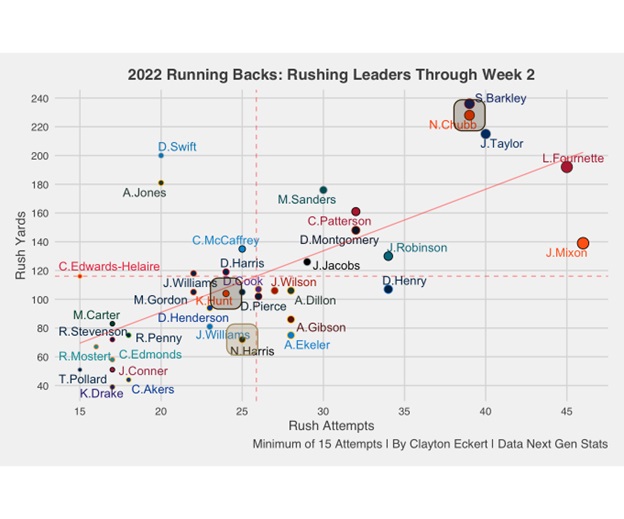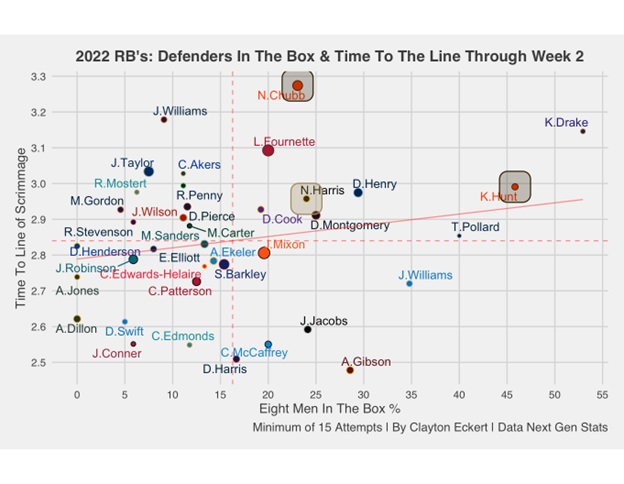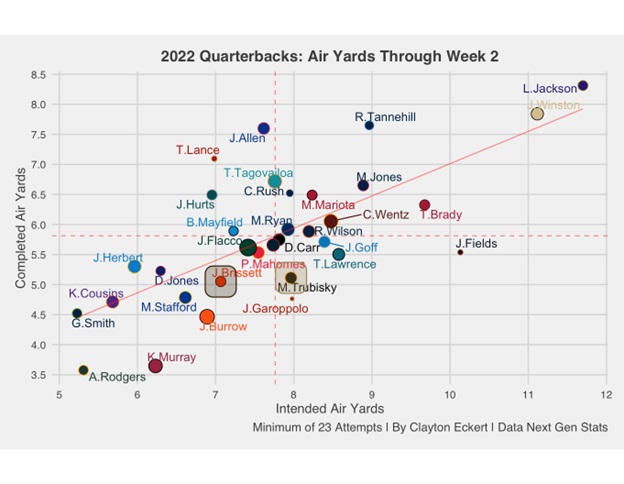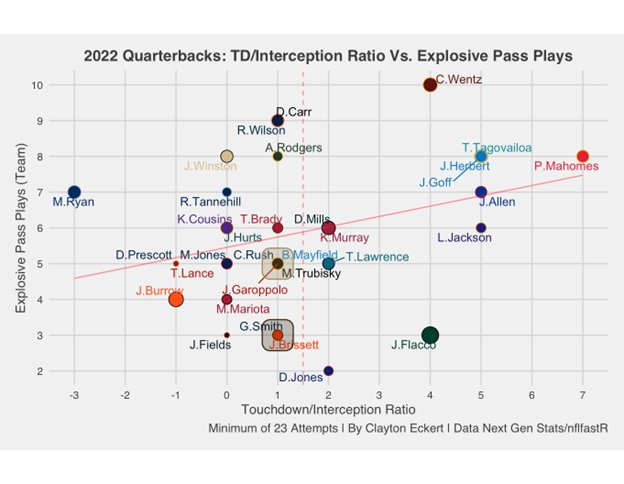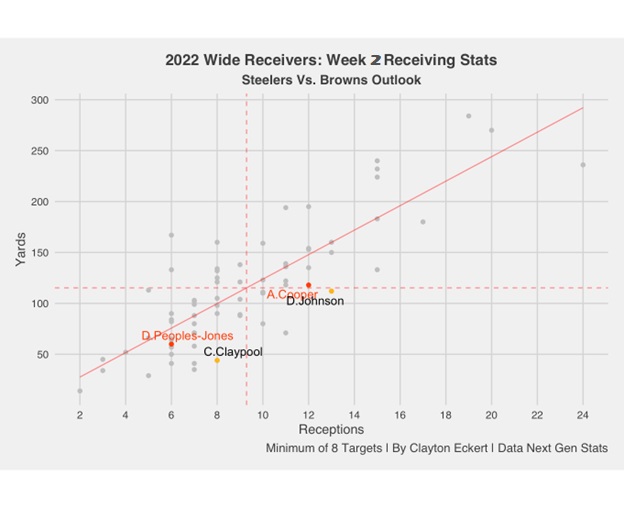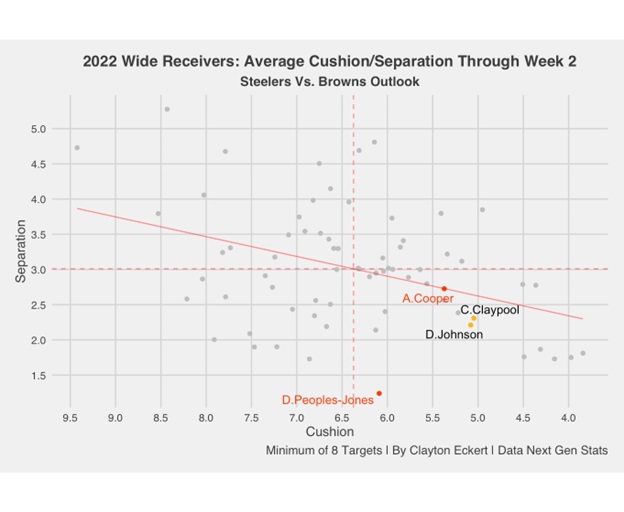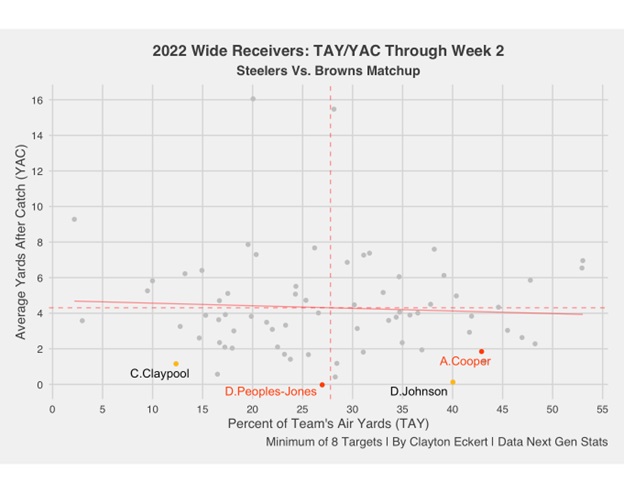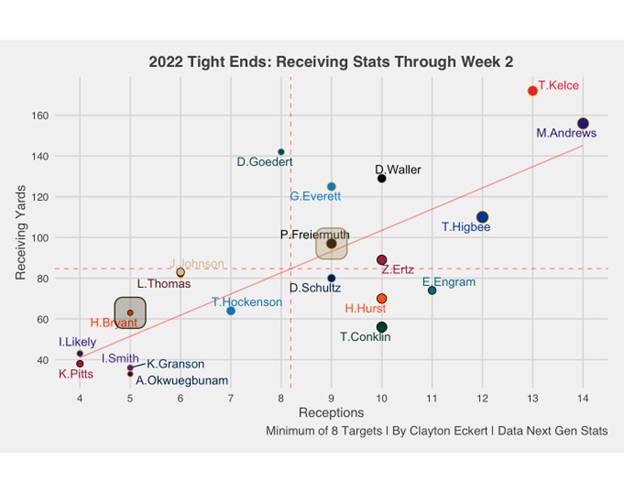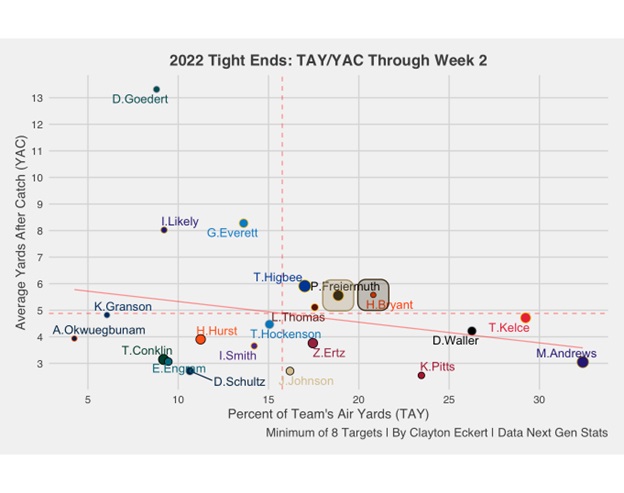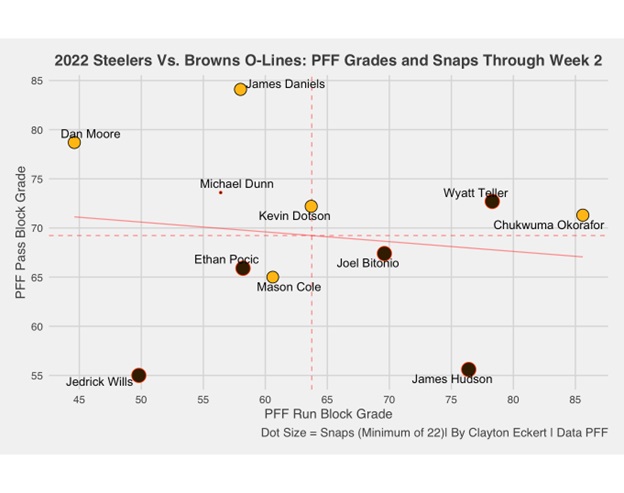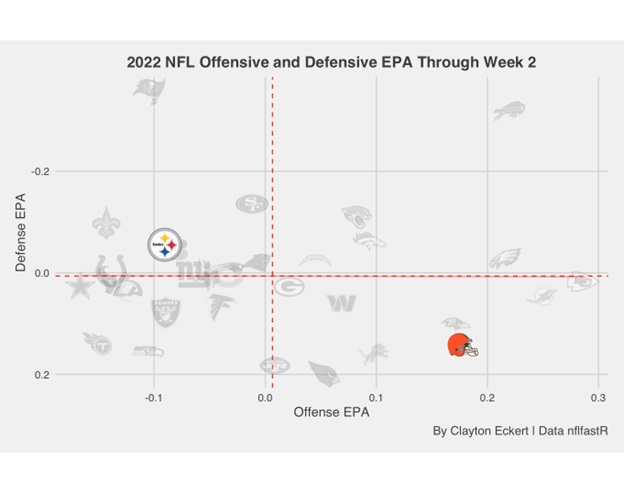Week 3 is upon us, a quick turnaround for a Thursday night game for the 1-1 Pittsburgh Steelers. They square off in an important early season game against division opponent Cleveland Browns, who sit at the same record. Today I’ll provide information and takeaways from the 2022 season as well as previous matchups, and pose some questions for you, the readers.
Let’s start with running back, a crucial and primary element to try and eliminate for Pittsburgh’s defense, as well as hopefully getting it ground game going more on offense. Here are the 2022 rushing stat leaders through two games:
Browns running back Nick Chubb is second in rush yards with 228 on 39 carries, for a healthy yards per carry of nearly six yards. He currently sits atop the NFL with three touchdowns as well, a patient runner that does a great job setting up his blocks and is hard to bring down. Chubb has a whopping 19 missed tackles forced on rushes, which is six more than any running back this season!
Fellow running back Kareem Hunt completes one of, if not the best one/two punches at the position in the league. Behind a good offensive line, (more on that later) Hunt has more rushing yards (104) on one less carry (24) than Steelers running back Najee Harris. Harris did have a better game in week two after bottoming out the rushing stats as I pointed out in my last outlook. Successful runs were a refreshing site for Pittsburgh in a largely stale offensive performance otherwise last week, sustaining a few drives in the middle of the game.
Next let’s gain more context on the rushing stats with eight defenders in the box % and average time behind the line of scrimmage:
This visual really illustrates my earlier point, with Chubb taking the most time behind the line of scrimmage, showing patience to set up his yardage along with the Browns employing outside runs at a high rate, which the Steelers defense must be ready for. Looking at the eight men in the box data, we can see all three primary backs have dealt with this at an above the mean rate. Hunt has the second highest eight men in the box percentage league wide, at 45.8%. Chubb and Harris have similar results, with the latter seeing eight men 24% of the time so far. Another big factor I’ll have my eye on is explosive runs (20 yards or more), which Cleveland has five of compared to none for Pittsburgh. That’s not Harris’ game, so the Steelers defense will have a tall task so the disparity hopefully doesn’t get out of hand. Encouragingly, Pittsburgh’s defense fared well against the run in both matchups last season, allowing 96 and 93 yards respectively, though Hunt was unavailable in the season sweep for the Steelers in 2021.
Receiving will also be a factor at the position, with Harris having the most targets (eight) of the players we’re focused on, catching all but one for 43 yards (6.1 yards per reception), and forcing two missed tackles on these opportunities (along with the same number on rushes). Hunt leads the charge for the Browns position room thus far as a receiver, catching all six of his targets for 40 yards for a 6.7 average, also forcing two missed tackles. He also has six forced missed tackles in the running game. Chubb has also caught all of his targets (4) for 28 yards, with an also impressive seven yard per reception.
Can the Steelers defense limit Cleveland’s running backs, particularly in the tackling department and explosive plays? How about Harris and Pittsburgh building on some positives from week two?
Next let’s look at the quarterbacks, with completed and intended air yards:
Pittsburgh quarterback Mitch Trubisky has had a slow start to say the least in this new look offense overall. He is just above the mean through two weeks with an intended air yards number of eight, which ranks 13th out of the 34 quarterbacks on the graph. This puts context to my passing locations charting for the Steelers, seeing how his seemingly low number of explosive attempts and pass distances stack up to the NFL’s average intended air yard numbers.
Trubisky and Browns quarterback Jacoby Brissett have similar completed air yard results though, with the former landing at 5.11 for a low rank of 26th compared to the latter’s 5.05 completed air yards that lands at the following rank. Brissett’s intended air yards are also below average at 7.06, which ranks 24th. If the data holds true, here’s to hoping the Steelers can win the TOX battle (turnovers and explosive plays) against a Cleveland team sans quarterback Deshaun Watson.
With this in mind, here are quarterbacks touchdown to interception ratios along with their teams’ number of explosive pass plays for context:
Here we can see the two quarterbacks for Thursday’s matchup with the same touchdown to interception ratio of one, and both teams below average in explosive pass plays. While below league average, Trubisky does have the edge in explosive passes with five along with two touchdowns and one interception through two games, compared to Brissett’s three explosive pass plays and identical touchdown/interception numbers. Here’s to hoping Pittsburgh can excel in this crucial facet of the game on both sides of the ball, with the better team likely coming out on top in my opinion.
Last thing for the quarterbacks, I wanted to provide aggressiveness (number of attempts into tight coverage where the defender is within one yard or less of the receiver at the time of completion of incompletion) along with their overall completion percentage:
Both Trubisky and Brissett rank high in aggressiveness, with Trubisky’s 23.9% being second most in the league. His 59.2 completion percentage has suffered and is below average and ranks 24th. In comparison, Brissett has a much better completion percentage (65.6%) that ranks 11th in the NFL on the fifth highest aggressiveness percentage. So, both quarterbacks have thrown tight window throws often, but Brissett has a stronger connection with his receivers thus far, on shorter targets overall. It will be interesting to see how the Steelers defend Brissett and company, will they play tighter coverage than they did against the Bengals and Patriots?
How do you think the quarterbacks will fare?
Now let’s look at wide receivers, starting with receiving stats through two weeks:
This visual shows similarities in what the top two receivers for each team have provided their team on the stat sheet in two games. Steelers wide receiver Diontae Johnson has the most receptions (13) and targets (20) in the outlook for this game, providing 112 yards with 8.6 yards per reception. He is yet to score a touchdown, and here’s to hoping this changes in week three. Amari Cooper was acquired from the Cowboys this offseason, and has fared well as the primary target for Brissett. Cooper has been targeted 16 times, catching 12 of them for 118 yards for a stronger 9.8 yards per reception along with a touchdown. Both receivers have provided several chain moving plays for their offenses, with Cooper’s eight first downs edging out Johnson by one.
Pittsburgh wide receiver Chase Claypool has eight receptions through two games on 11 targets, with 44 yards and 5.5 yards per attempt. Really would like to see he and Trubisky connect downfield, perhaps on a slot fade like we saw in the preseason against the Jaguars as opposed to being largely limited to five-yard outs and short passes. Cleveland wide receiver Donovan Peoples-Jones has the second most targets (12) for the Browns, but only six catches (50%) for 60 yards for an average of ten yards per reception. Also looking for more involvement and connection from Trubisky to wide receiver George Pickens, considering his six targets but only two receptions for 26 yards. Cleveland’s secondary has struggled thus far, so here’s to hoping the Steelers passing game can excel in the matchup.
Next let’s look at cushion (distance in yards measured in yards between the receiver and the defender they are matched up against at the time of the snap on all targets) and separation (distance in yards measured between the receiver and the nearest defender at the time of catch or incompletion):
Here we get context to how the receivers were defended on their targets, with Claypool and Johnson landing nearly identical on the graph. They have the ninth and tenth ranks in least amount of cushion league-wide along with the 14th and 15th rank in least amount of separation, with Claypool on top of each result. This helps me highlight an extremely frustrating facet and usage of the passing game so far in 2022, with the lack of route variety along with player execution on breaks not allowing separation. This is especially frustrating when it comes to Johnson, knowing his elite ability in this regard. Here’s to hoping we see Johnson provide a clinic in his route running against Cleveland’s secondary, considering the scheme will likely be similar on a short week of preparation.
All four wide receivers in our sights are below the mean in separation, and hopefully the data holds true with Pittsburgh’s defense providing tight coverage against Brissett. Cooper does have the highest result in the outlook in separation, but was also given slightly more cushion at the line of scrimmage. Peoples-Jones result is very telling, with the most cushion at the line of the four receivers and especially seeing his least amount of separation in the entire NFL, giving great context to his poor catch percentage.
Last up for the wide receivers, let’s see their percent of teams air yards (sum of receivers total intended air yards over the sum of the teams total intended air yards) along with average yards after catch:
Right away we can see that yards after catch has lacked overall, with each receiver in the outlook at under two yards. Cooper leads the outlook with 42.9% TAY that ranks ninth in the NFL, with best YAC result in the outlook but 12th least in the NFL. The majority of his routes have come out wide, and Pittsburgh’s secondary will have their hands full. Johnson has a TAY number of 40.03% that ranks 13th. Peoples-Jones is just below the mean, with 26.96% TAY for the Browns, and the least amount of YAC in the NFL, the only negative number at -0.03. Johnson was the only player with a negative average YAC last week, but moves to a positive number of .13, but second worst rank in the NFL. Claypool’s TAY sits at 12.34, which is fifth least of players with a minimum of eight targets. He also has a low YAC rank that is fifth least in the NFL, and here’s to hoping Pittsburgh’s offense can see a positive trend in YAC to make life easier on Trubisky and the pass game as a whole.
Which wide receiver room will have the stronger game?
Now for the tight ends, a key position for the game with the Browns position room typically having strong games against the Steelers, along with Steelers tight Pat Freiermuth doing well overall to start the season as a receiver. Here are the receiving stats for the position in 2022 thus far:
Freiermuth is above the mean at the position tied for the sixth most receptions (9) along with the seventh rank with 97 yards on 16 targets, which ties for fourth most in the NFL. Looking for the connection with Trubisky to continue improving, with only a 56.3% completion rate compared to one of the highest ranks for much of the 2021 season. Freiermuth has a 10.8 yards per reception number, which is respectable considering several checkdown plays he has been utilized on.
Browns tight end Harrison Bryant leads the Browns position room with eight targets, five receptions, 63 yards, and a 12.6 yards per reception average. This could be a big factor, and here’s to hoping Pittsburgh’s linebackers and secondary fare well against him as they did against the Patriots tight ends last week, who were targeted four times with zero catches. Fellow tight end David Njoku has had success against the Steelers in recent memory, and has six targets, four receptions, and 39 yards for a 9.8 yards per reception number.
Here is a similar view to the wide receivers, with percent of teams air yards and average yards after catch thus far for the tight ends:
This visual really adds great context to the receiving stats, with Freiermuth and Bryant being two of the four tight ends above the mean in both data points. Bryant has the fifth highest TAY of 20.8%, compared to 18.87% for Freiermuth, which ranks sixth. The also land very close in YAC, with Bryant’s 5.58 number barely edging out Freiermuth’s 5.56, for the same ranks respectively. Here’s to hoping the Steelers can get a big game out of Freiermuth, and looking for him to provide a positive trend as a blocker, struggling in this regard so far this season.
How do you think Freiermuth will fare in this game? How about the Browns position room?
Speaking of blocking, the offensive lines are obviously a key component in the matchup, and here’s how they have fared in both the run and pass game according to PFF grades:
Right away we can see Steelers guard James Daniels has the best pass blocking grade (84.1) in the showdown, which also ranks ninth league-wide! His 58-run block grade is below the mean in the outlook though, but hopefully he can improve in this regard with Cleveland’s interior defensive line being the weaker link of the unit. Steelers tackle Chukwuma Okorafor has the strongest run blocking grade of the group (85.6), which ranks sixth in the NFL, along with an above the mean 71.3 pass block grade. With defensive lineman Jadeveon Clowney being ruled out on the Browns final injury report, along with fellow edge rusher Chase Winovich going to IR, hopefully Okorafor and the Steelers can take advantage, and really hoping they test the Browns with runs to the right side (and/or away from Garrett if he moves around more). Pittsburgh guard Kevin Dotson lands above the mean in both data points along with Okorafor, with a stronger grade as a pass blocker (72.2) along with a 63.7 run block grade.
Steelers tackle Dan Moore has shown encouraging improvements as a pass blocker with a 78.7 grade, but has struggled as a run blocker with the lowest 44.6 grade in the matchup through to weeks. Moore has a tough task against Browns defensive lineman Myles Garrett this week, who is tied for third in the NFL with three sacks, and it will be interesting to see how Garrett looks considering he was limited on Wednesday but appears good to go. Pittsburgh center Mason Cole is the only lineman on the team who is below the mean in both data points, with a 65-pass block grade and 60.6 as a run blocker. So, hoping to see Pittsburgh’s o-line show more of a positive trend in the run blocking department, after showing encouraging things that will hopefully continue in the pass game.
The Browns are strong at the position overall, but right guard Wyatt Teller is the one above the mean in both data points according to PFF, with a 78.3 run block grade along with a 72.7 pass block grade. James Hudson fared well in two games as a run blocker for Cleveland, but was filling in for starting right tackle Jack Conklin who will make his season debut on Thursday. This is huge news, especially with Pittsburgh not having a sack against the Patriots in week two sans edge rusher T.J. Watt, so the play of edge rusher Malik Reed is one of the many keys I’ll have my eye on for hopeful victory. Browns left guard Joel Bitonio has a 69.6 run block grade along with a 67.4 pass block grade. The Browns have two players below the mean in both data points, center Ethan Pocic (65.9 pass block, 58.2 run block grades) and left tackle Jedrick Wills (55 pass block, 49.8 run block grades). It will be crucial in my opinion that Steelers edge rusher Alex Highsmith (who is tied with Garrett at three sacks) win this primary matchup. Pittsburgh’s defensive line will sure have its hands full, and hoping Cameron Heyward can have a big game to ease the strain on the Pittsburgh edge rushers, as well as lead the charge against the run against this strong Browns o-line.
Can Pittsburgh’s defense stand up against a strong Browns front? How will Pittsburgh’s o-line fare?
To close, here is a total overview using teams’ expected points added on offense/defense:
Here we can see how the teams for Thursday nights game have fared, along with around the league. The Browns have performed well in this regard on offense, with the fifth rank on offense of 0.178. Diving into this a bit further, Cleveland is top ten in several aspects thus far on offense. They have a total success rate of 47.2% that ranks 10th, an EPA per dropback of 0.192 and 50% dropback success rate that each rank ninth, and their rushing EPA expectedly strong at 0.163 that ranks fourth, along with a rush success rate of 44.3% that ranks tenth. This is a facet to their running game I found researching the 2021 season, and hammers the point of limiting explosive plays from earlier as opposed to being nickeled and dimed down the field compared to other teams.
Pittsburgh’s offensive numbers are just that so far, ranking 24th with a -0.09 offensive EPA. Their total success rate of 38.7% ranks 29th, dropback EPA of -0.117 ranks 24th, and a dropback success rate of 38% that ranks 28th. Their strongest results through two weeks are in the run game, with a rush EPA ranks at the middle of the league at -0.066 (16th) along with a rush success rate of 40% that lands at 20th.
The Steelers defense lands above the mean with a -0.055 EPA that ranks seventh in the league, with a total success rate allowed of 42.7% that ranks 11th, a -0.077 dropback EPA allowed (sixth), but a dropback success rate allowed of 47.7% that ranks a much lower 22nd. This highlights the zone “keep everything in front of you scheme”, allowing successes but limiting the big play. Pittsburgh’s defense also has the 22nd rank in rush EPA allowed (-0.032), and their best result of rush success rate allowed (32.7%) holds true in this matchup, ranking third in the NFL!
The Browns defense has been their disappointment overall to start the season, with a 0.14 EPA that ranks 28th. Their total success rate allowed of 40.2% (seventh) is one of their better marks, but have struggled against the pass with a 0.225 dropback EPA allowed that ranks 28th, a dropback success rate allowed of 42.4% (ninth), a rush EPA allowed that ranks 16th, and a rush success rate allowed of 35.1% that ranks eighth. Linebacker Jeremiah Owusu-Koramoah leads the team with 14 combined tackles, including three for a loss and a forced fumble, also providing nine stops as a key contributor to the Browns limiting their opponents success rates. The safeties are a group to watch as well, starting with Grant Delpit having 13 combined tackles and the only team interception thus far. Fellow safety John Johnson has 11 combined tackles, a combined sack, and a pass deflection. The cornerbacks have struggled as I mentioned earlier, with each allowing at least one touchdown. Greg Newsome has been the most targeted (14) with a 120.8 Passer Rating Against, and Denzel Ward has particularly struggled with three missed tackles, two touchdowns allowed, and a 158.3 Passer Rating Allowed which is the lowest mark possible. Can the Steelers wide receivers benefit and boost the passing game that has been lacking?
Who do you think will come out the victor in this important divisional showdown? Thanks for reading and let me know your thoughts in the comments!


